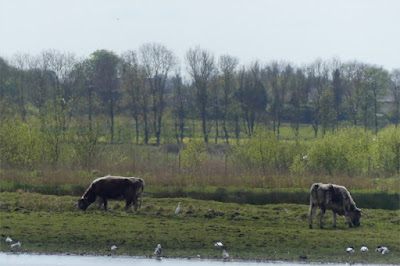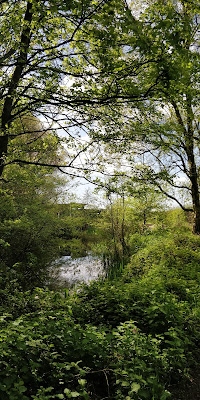 |
| Linnet, New Lane |
It was a bright, sunny day just right for a roundabout walk around Martin Mere. A slight hiccup at Wigan where the train had to be rebooted to get one of the engines running had me arriving at New Lane ten minutes late but no matter, it had got me there. The sun was bright and a cool North wind told me I'd made the right choice of jacket and the walking was going to be good.
 |
| By New Lane Station |
House sparrows chased each other round the hedgerow by the station while blackbirds, robins, chiffchaffs, blackcaps, woodpigeons, wrens and a whitethroat sang from the hedgerows by the line. It was to be another day of busy songscapes. Black-headed gulls flew hither and thither, oystercatchers split their time between a newly ploughed field and the water treatment works and every so often mallard threesomes would fly by.
 |
| Walking by the railway line, the field of fennel on the left |
There wasn't a lot of ground cover left: the stubble had been ploughed, the carrots were scant inches tall and the fennel had been cut back nearly to ground level. Which made it all the more frustrating to struggle so much finding the linnets I could hear tweeting at each other. It felt odd walking through huge clouds of midges and not having swallows and martins overhead hoovering them up but the northerly winds of the past couple of weeks have set things back a bit. Looking back I find I blame North winds and bad weather in Spain for my poor showing in the April passage migration every year.
 |
| Meadow between the railway line and Martin Mere |
There were two pairs of stonechats on the meadows on the other side of the line, one pair in brambles by the line and the usual pair on the collapsed shed who had hungry mouths to feed. The linnets took pity on an old man and sat in the trees so I could see them properly. Now I'd passed all the midge clouds a couple of swallows flew overhead.
 |
| Stonechats, New Lane |
I joined the path round the outside of the reedbed walk, much to the irritation of a pheasant which made a noisy exit and a Cetti's warbler which gave an alarm call I've only ever heard a couple of times. My usual experience is that Cetti's either quietly disappear or knock you off your feet with a song. A chiffchaff dithered between giving an alarm call and singing and eventually opted for the latter, sounding not quite right in the process.
 |
| By the reedbed walk |
In the shelter of the hedgerows it was becoming a mild Spring lunchtime. The chiffchaffs outnumbered the willow warblers ten to one. More Cetti's warblers sang in the hedgerows than in the reeds. They were accompanied by robins, blackcaps, wrens, great tits, blackbirds, dunnocks, chaffinches and a couple of whitethroats. Did I say it was a busy songscape? Blue tits, reed buntings and long-tailed tits quietly went about their business in the hawthorns, unlike the three buzzards soaring overhead which let everyone know they were around.
It felt strange walking this path and not getting my feet wet, the relatively dry spell and drying winds had done their work. The sun brought out the butterflies, the open patches of meadow were busy with orange tips and peacocks.
 |
| Marsh harrier, Martin Mere |
The hedgerow on the left gave way to reedbed margins and a couple of reed warblers joined the fray. Coots and mallards could be heard by pools, Canada geese cruised about noisily and whooper swans could be heard in the distance. A couple of female marsh harriers soared low overhead.
 |
| Marsh harrier, Martin Mere |
The path I was dreading, the one along the fence to the road, was passable without even getting my boots muddy despite the pair of mallards swimming in one of the potholes. I tried not to disturb them but made a bad fist of not disturbing the pheasants, shelducks and woodpigeons in the field.
 |
| Nesting black-headed gulls, Martin Mere |
I went straight to the Discovery Hide and squinted through the glare of a high key sunny afternoon. I miss the Swan Link Hide which might have been dangerously rickety but at least didn't face into the sun. Mallards dozed on the bank while pigeons courted and black-headed gulls squabbled. More black-headed gulls dozed on nests on the rafts and islands or drifted on the mere picking at midges. A few shelducks and tufted ducks cruised about, a few pairs of shovelers loafed on an island over by the far bank.
 |
| Mallard, Martin Mere |
It took me a while to spot the pair of Mediterranean gulls swimming amongst the black-headed gulls. I was taken by how fast they swam compared to the black-headed gulls, one glance away and they'd be somewhere else entirely.
 |
| Black-headed gulls and Mediterranean gull (back), Martin Mere |
Half a dozen whooper swans loafed on the far bank while Canada geese and greylags quarreled noisily around them. A dozen or so grazing pink-footed geese kept well away from the fuss. For a long time I didn't notice the couple of cattle egrets with the grazing longhorns. Over on the distant fields little egrets, lapwings and woodpigeons flew to and fro. Something disturbed one group of lapwings and they, in turn, disturbed a heron and a great white egret.
 |
| Longhorn cattle, cattle egret and black-headed gulls, Martin Mere |
The tree-lined walk to the Kingfisher Hide (I can't remember its new name) was relatively quiet. Goldfinches twittered and sang and a song thrush sang from a treetop. The titmice, robins and chaffinches quietly fossicked about in the undergrowth and the bird feeding station was deserted.
 |
| Singing linnet by the Kingfisher Hide |
A pair of long-tailed tits were hunting spiders in the eaves of the Kingfisher Hide. Outside the brambles were busy with linnets and a couple sang from the shrubs nearby.
 |
| From the Kingfisher Hide |
There were more goldfinches and titmice on the walk down to the Ron Barker Hide. The hide was almost deserted, I was on my own upstairs and could hear a couple of people downstairs. The water levels were down a bit on the marshes so the islands weren't inundated. Black-headed gulls and shelducks drifted about on the pool to the left. On the right avocets and black-tailed godwits fed in the water and teal dozed on the bank. Greylags and a couple of pairs of gadwall drifted about in the drain between the pools.
 |
| Longhorn cattle and cattle egret by the Ron Barker Hide |
There were more greylags with the Canada geese and pink-feet grazing on the marsh. Another cattle egret accompanied the longhorns by the hide. A few swallows passed by and didn't stop. A very dark, gull-like wader flew by and, mercifully, turned slightly so I could see its bill and confirm it was a whimbrel.
On my way back I had my usual look round for roosting tawny owls in the ivies and had my usual luck in not finding any. Once a year I do which makes it worth the effort.
 |
| The pedestrian exit from Martin Mere |
 |
| Tarlscough Lane |
It was a bright, sunny walk back and the cool breeze had lessened. Farmers were busy ploughing and sowing fields that were sodden mudscapes a few weeks ago, their tractors haunted by small groups of black-headed gulls, rooks and jackdaws. Goldfinches and corn buntings sang in the hedgerows while house sparrows and greenfinches fussed about. Out in the fields woodpigeons and starlings combed the already ploughed fields. I thought I could hear yellow wagtails but had no joy finding them. It was worth the while looking as I found pairs of grey partridges skulking in field margins.
I didn't have long to wait for the train back to Manchester. This one had to be rebooted at Appley Bridge but I still — just — got my train home which wasn't cancelled this time.
I found out later that I'd just missed three cranes flying over the Ron Barker Hide, I'd have missed them anyway had I heard and gone back, they were flying at a rate of knots and were over the Fylde an hour later and were later seen near Leighton Moss. There's a lot of blink and you'll miss it to the Spring migration.
 |
| Walking up to the Ron Barker Hide |

No comments:
Post a Comment